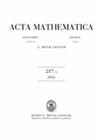The Fuglede conjecture for convex domains is true in all dimensions
IF 6.7
1区 数学
Q1 MATHEMATICS
引用次数: 44
Abstract
A set $\Omega \subset \mathbb{R}^d$ is said to be spectral if the space $L^2(\Omega)$ has an orthogonal basis of exponential functions. A conjecture due to Fuglede (1974) stated that $\Omega$ is a spectral set if and only if it can tile the space by translations. While this conjecture was disproved for general sets, it has long been known that for a convex body $\Omega \subset \mathbb{R}^d$ the "tiling implies spectral" part of the conjecture is in fact true. To the contrary, the "spectral implies tiling" direction of the conjecture for convex bodies was proved only in $\mathbb{R}^2$, and also in $\mathbb{R}^3$ under the a priori assumption that $\Omega$ is a convex polytope. In higher dimensions, this direction of the conjecture remained completely open (even in the case when $\Omega$ is a polytope) and could not be treated using the previously developed techniques. In this paper we fully settle Fuglede's conjecture for convex bodies affirmatively in all dimensions, i.e. we prove that if a convex body $\Omega \subset \mathbb{R}^d$ is a spectral set then it can tile the space by translations. To prove this we introduce a new technique, involving a construction from crystallographic diffraction theory, which allows us to establish a geometric "weak tiling" condition necessary for a set $\Omega \subset \mathbb{R}^d$ to be spectral.凸域的Fuglede猜想在所有维度上都是正确的
如果空间$L^2(\Omega)$具有指数函数的正交基,则称集合$\Omega\subet\mathbb{R}^d$是谱的。Fuglede(1974)的一个猜想指出,$\Omega$是一个谱集,当且仅当它可以通过平移来平铺空间。虽然这一猜想在一般集合中被证明是错误的,但人们早就知道,对于凸体$\Omega\subet\mathbb{R}^d$,该猜想的“平铺意味着光谱”部分实际上是正确的。相反,在$\Omega$是凸多面体的先验假设下,仅在$\mathbb{R}^2$中证明了凸体猜想的“谱暗示平铺”方向,并且在$\math bb{R}^3$中也证明了这一方向。在更高的维度中,这个猜想的方向仍然是完全开放的(即使在$\Omega$是多面体的情况下),并且不能使用以前开发的技术来处理。在本文中,我们完全肯定地解决了Fuglede关于所有维度上凸体的猜想,即我们证明了如果凸体$\Omega\subet\mathbb{R}^d$是一个谱集,那么它可以通过平移来平铺空间。为了证明这一点,我们引入了一种新技术,该技术涉及晶体衍射理论的构建,使我们能够建立集合$\Omega\subet\mathbb{R}^d$是光谱的必要几何“弱平铺”条件。
本文章由计算机程序翻译,如有差异,请以英文原文为准。
求助全文
约1分钟内获得全文
求助全文
来源期刊

Acta Mathematica
数学-数学
CiteScore
6.00
自引率
2.70%
发文量
6
审稿时长
>12 weeks
期刊介绍:
Publishes original research papers of the highest quality in all fields of mathematics.
 求助内容:
求助内容: 应助结果提醒方式:
应助结果提醒方式:


